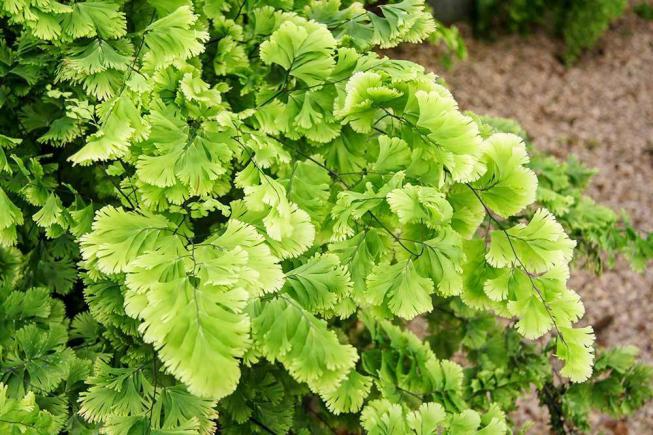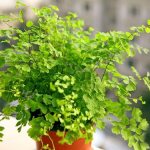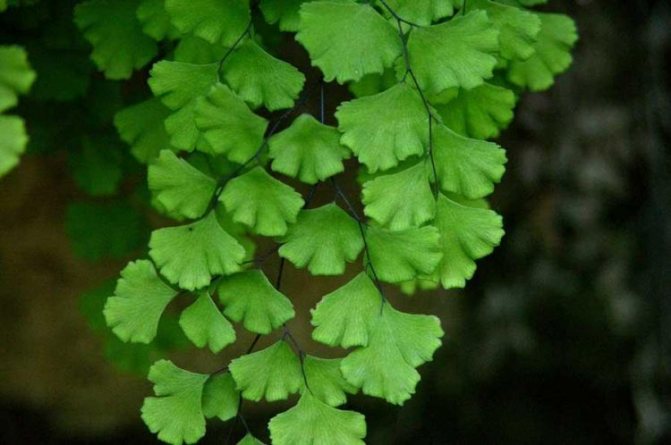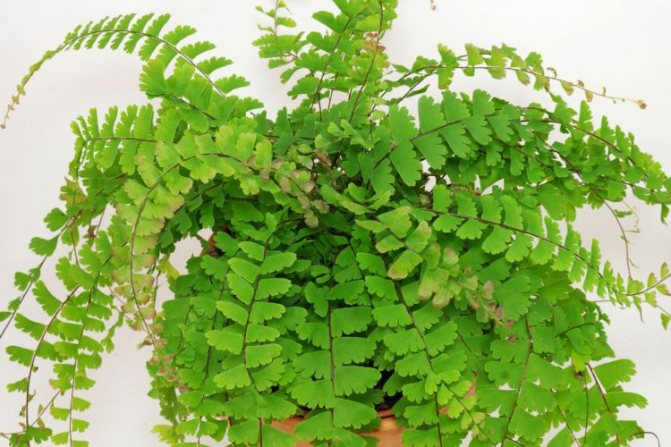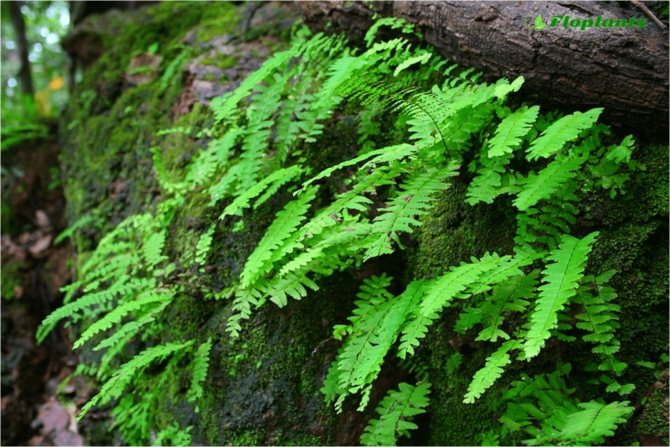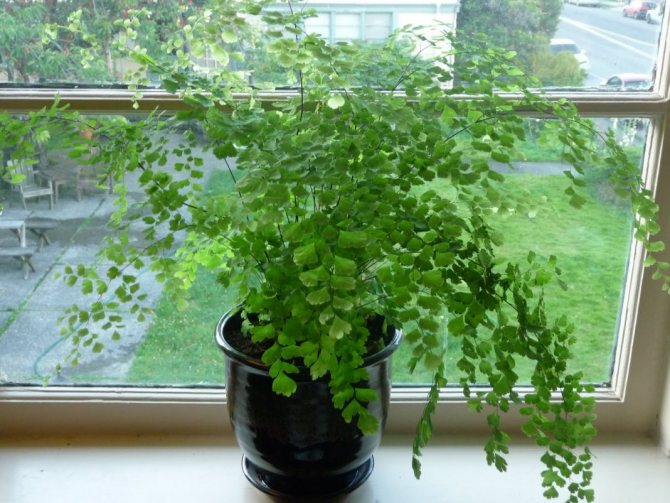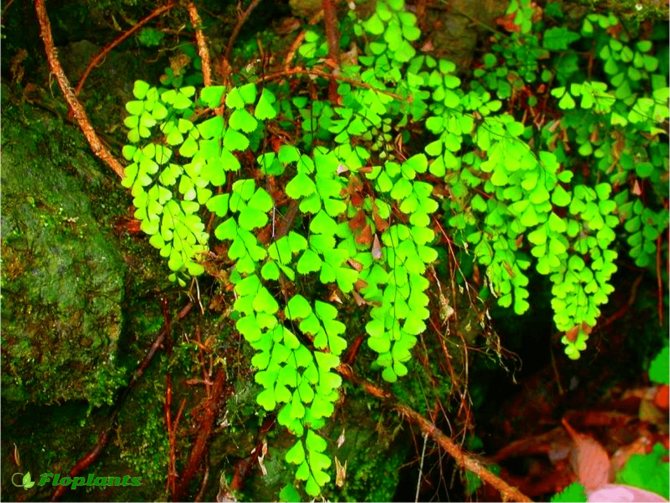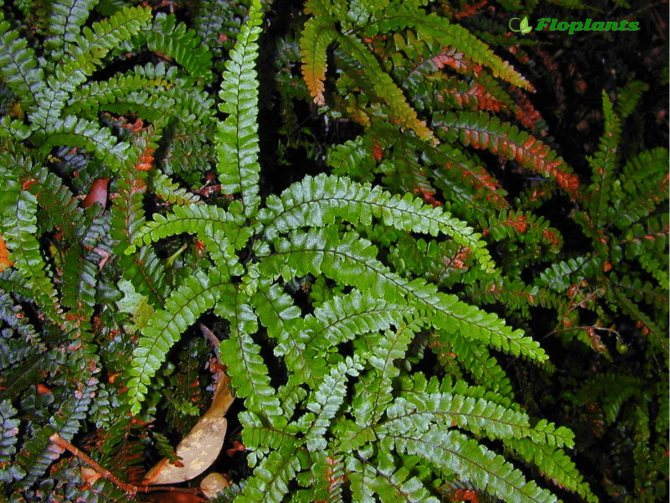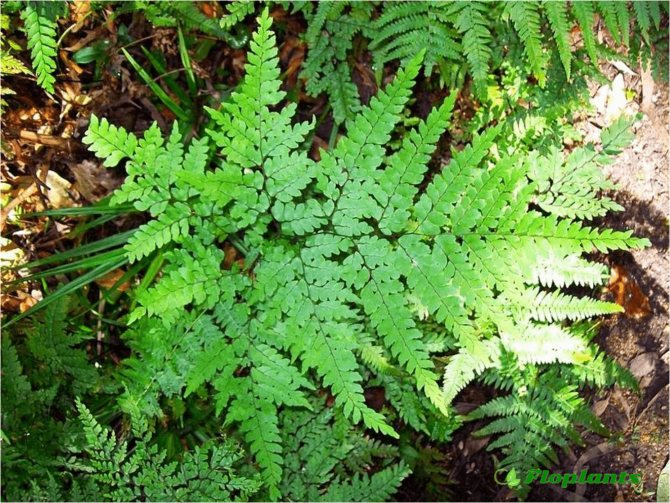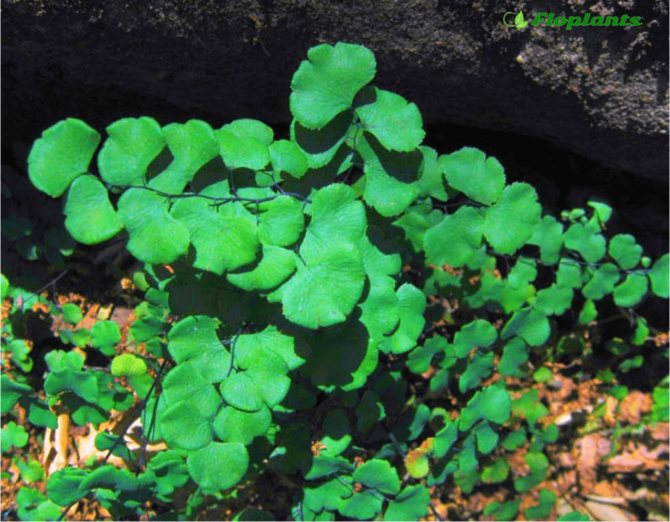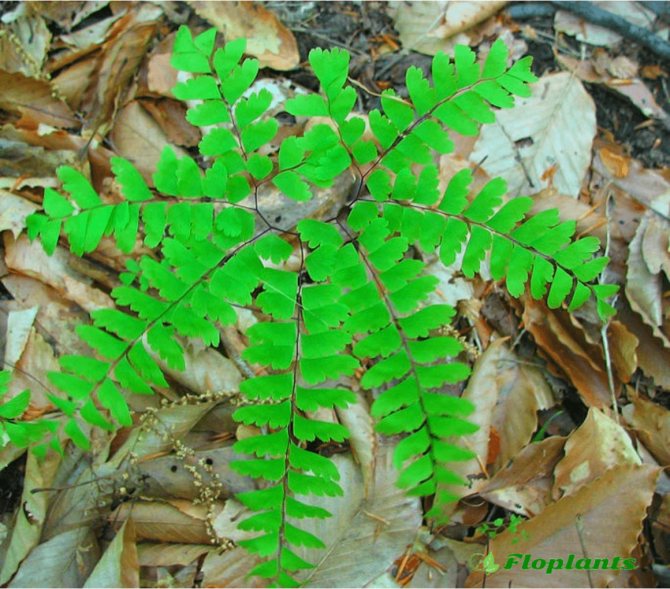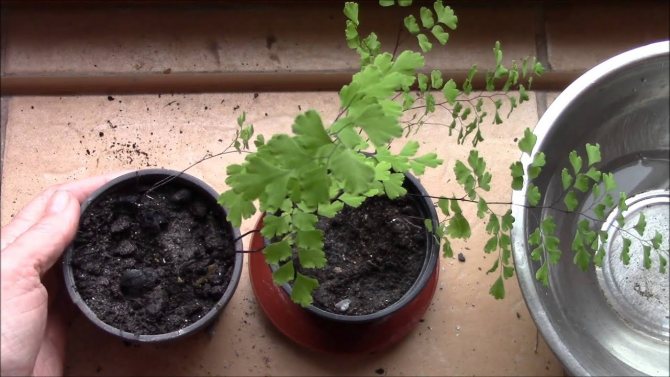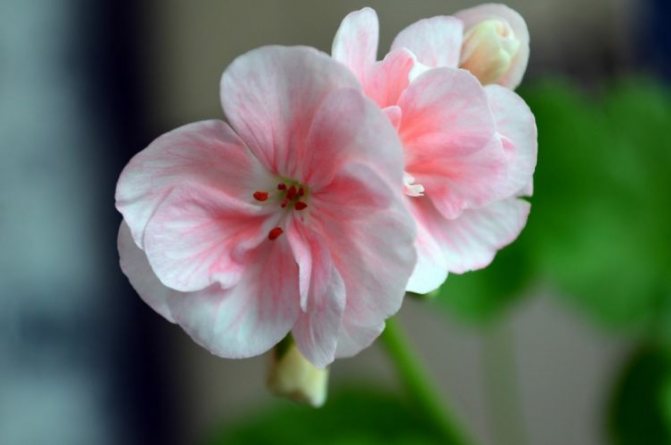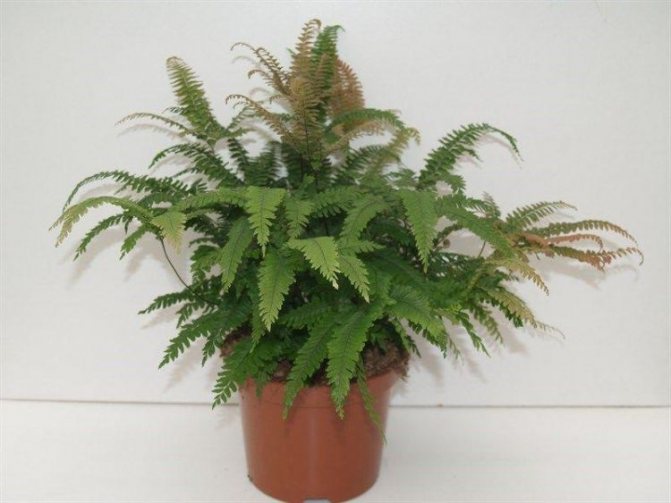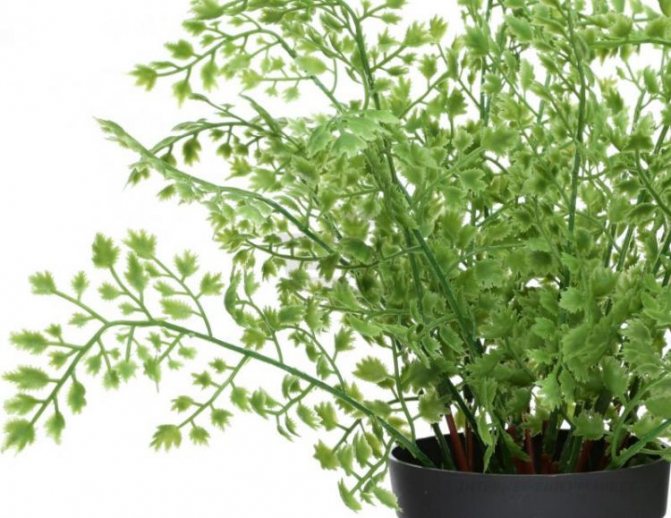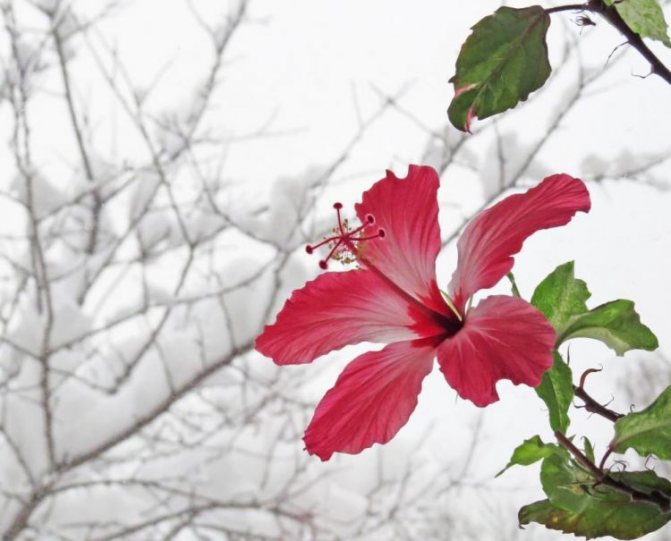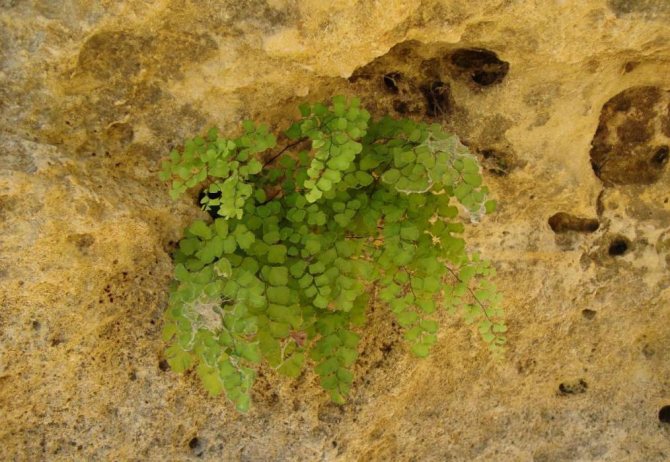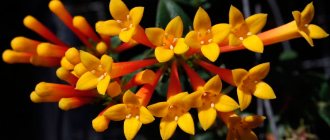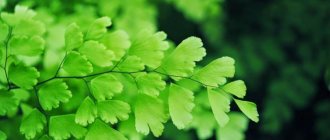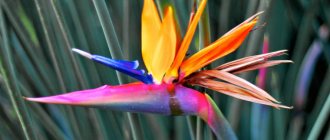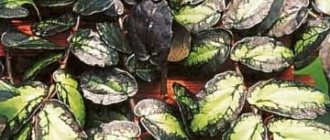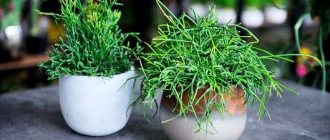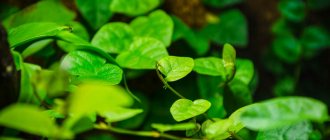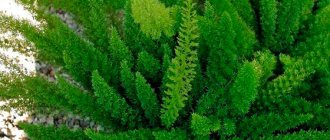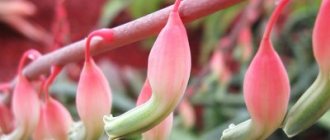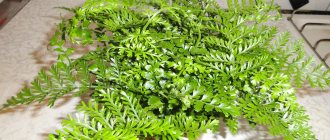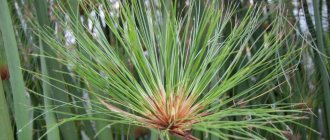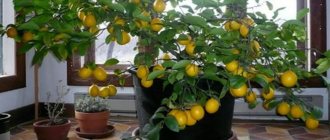The maidenhair is considered a species of fern and is often found near water bodies or in forests with high humidity. Translated from Greek, the name means "waterproof" ("a" - not, "diantum" - weeping), since its leaves are covered with a special layer that repels rainwater.
The plant also has several nicknames: Venus hair or maiden curls.
Content
- Listen to the article
- Description
- Maidenhair care How to care
- Watering
- Maidenhair transplant
- Pests and diseases
- Properties
- Dividing the bush
- Adiantum capillus-veneris
Dormant period
The resting time in the maidenhair, like in all species of ferns, is not as pronounced as in other flowering plants. Its dormant period is from November to March, when growth only slows down. During this time, there is no need to carry out any special events. You just need to remove the pot from heating appliances, provide high humidity and diffused light, and also protect it from drafts.
Watering should also be reduced (see the article above for more information on this).
Planting and caring for the maidenhair
- Bloom: does not bloom.
- Lighting: penumbra (north and east windows).
- Temperature: in summer - no higher than 22 ˚C, in winter - about 15 ˚C.
- Watering: regular: in the summer - 2 times a week, in the winter - once. It is recommended to use the bottom watering method: immersing the pot with the plant in a container of water.
- Air humidity: increased. In hot weather, daily spraying is recommended.
- Top dressing: from April to September with a fertilizer solution for decorative deciduous plants at half the dosage indicated in the instructions. In winter, the plant is not fed.
- Rest period: from October to February.
- Transfer: on average, once every 2-3 years.
- Reproduction: division of the rhizome and spores.
- Pests: scale insects, mealybugs, aphids, spider mites.
- Diseases: loss of decorativeness due to improper care.
- Properties: the plant has medicinal properties widely used in Western Europe and Chinese traditional medicine.
Read more about growing maidenhair below
Soil requirements
The root of the plant has a superficial location, so a wide and shallow pot can be used for growing. The drainage layer must be thick enough. Ready-made soil for ferns can be purchased at the store, only you need to add a little chopped sphagnum moss and charcoal to it. The soil for a home flower hair venus is nutritious, slightly acidic and porous. It should dry quickly and absorb water well.
Approximate composition of substrates:
- They are added to 2 parts of peat land, one part of humus and leaf land, as well as 1/2 part of sand.
- Leafy soil and peat (3 parts each), 2 parts of sod land, humus and sand (1 part each) are mixed;
- Leafy earth (3 parts) is mixed with peat soil (2 parts), with humus and coarse sand (one part at a time);
- Equal shares of peat, sand of coarse and sod land are mixed;
- Pine bark, coconut fibers, leafy earth and humus are mixed in equal parts.
Fern maidenhair - description
The maidenhair fern is a herbaceous perennial with a thin creeping rhizome covered with black or brown matte scales. The leaves of the maidenhair are opposite or alternate, on shiny dark petioles up to 25 cm long, covered at the base with scales. The leaf plate is green, sometimes gray, wide and smooth, strongly dissected, its wedge-shaped, obovate or trapezoidal segments are fan-shaped. Round, oblong or linear sori with sporangia are located along the veins on the underside of the segments.
In outdoor gardening, the maidenhair of the foot is usually grown, and the indoor maidenhair is most often a plant called "hair venus", as well as Ruddy's maidenhair, transparent, delicate and others.
- Pistia layered and its varieties

General information
Caring for a maidenhair plant requires the same patience and diligence as caring for your hair. In the process of growing at home, it is nourished, moisturized, cut and washed.
It should be noted that this type of fern, in comparison with other houseplants, has an important advantage - when grown at home, it does not need a lot of light. The flower feels great both in partial shade and in the shade. Proper care of this plant will allow you to enjoy the patterned and luscious greenery that adorns even the dark corners of the house for many years. There are many beautiful indoor plants. Venus hair is the most delicate and elegant among them.
Its name comes from the Greek a diant, which means "do not wet". This is due to the fact that the surface of the leaves of the plant seems to be covered with a film - water does not stay on them, it immediately flows off.
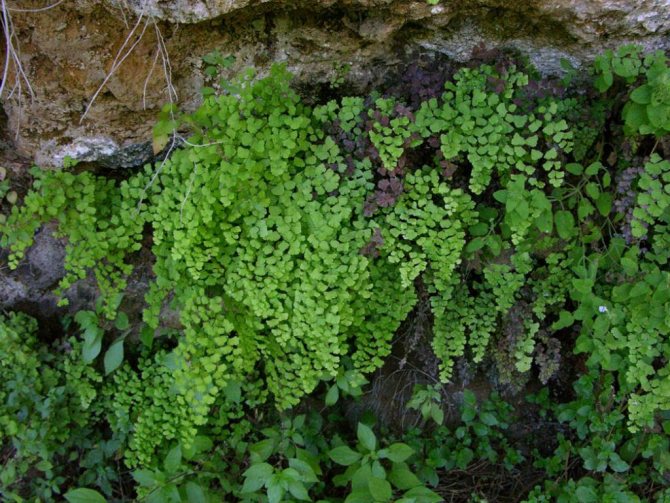

Home care for maidenhair
How to care for maidenhair
The houseplant maidenhair does not tolerate direct sunlight, preferring partial shade, so it should be placed near the eastern or northern window sills, since the light green lace fern leaves die off from too bright light.
The maidenhair loves clean air at home, but does not tolerate drafts, as well as dust, so wet cleaning in the room where this home fern is located will have to be done often, as well as airing the room. You cannot smoke near it, and the kitchen fumes can destroy the plant. The sultry air also harms the maidenhair: in summer, the temperature in a room with a fern should not rise above 22 ºC, and in winter it is comfortable to be in a room with a temperature of 15 ºC away from heaters.
Try to move the pot with the plant as little as possible - it does not like this. But what the maidenhair fern loves is daily spraying with warm water during the hot period, but when the temperature in the room is cool (this happens in the off-season, when autumn has already arrived, but the central heating has not yet been turned on), spraying can harm the plant. Fertilize maidenhair from April to September with liquid fertilizer for indoor ornamental deciduous plants at half the dose recommended by manufacturers once every three weeks. In winter, maidenhair does not need feeding.
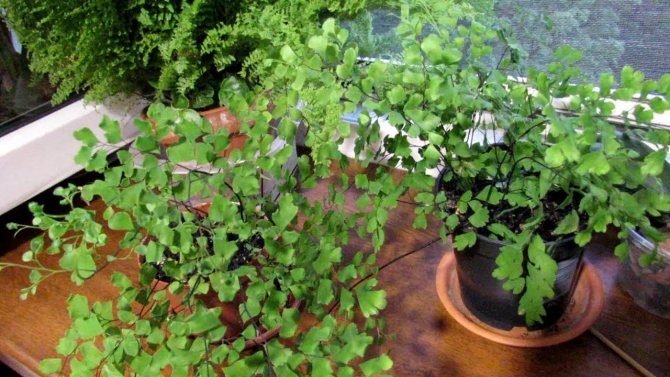

To preserve the decorativeness of the fern in the spring, it is advisable to cut off all yellowing, lethargic and aged leaves so that the plant spends its energy on the formation of new wai. After pruning, the plant is sprayed and watered.
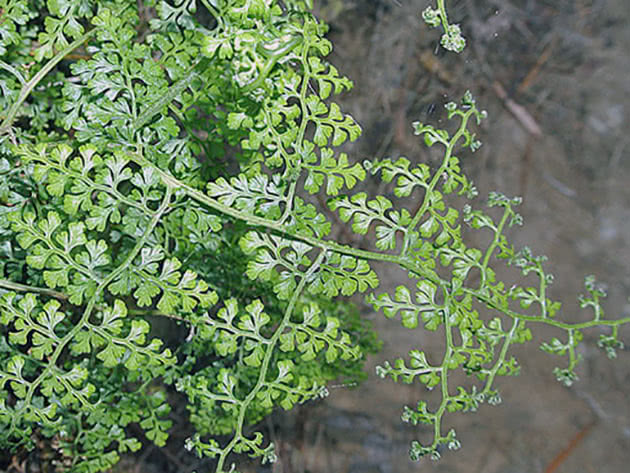

Watering the maidenhair
Caring for the maidenhair fern involves regular watering of the plant, and it is very important not to allow the earthy coma to dry out, because this can lead to drying out and death of the leaves. Waterlogging can cause rotting of plant roots.
In order to avoid uneven watering, the maidenhair together with the pot is immersed in a vessel with settled water at room temperature and kept in it until the top layer of soil in the maidenhair pot shines with water. After that, the fern is rearranged into the sink, allowed to drain off excess water and returned to its permanent place. In winter, the plant needs much less water, so it will have to be watered less often, but the principle of watering remains the same. The approximate frequency of watering in summer is twice a week, in winter - once.
Maidenhair transplant
Maidenhair loves a cramped pot, it develops slowly, therefore, it needs to be transplanted once every two to three years in spring, when the roots of the plant begin to peep out of the drainage holes, and the old plant only requires an annual replacement of the top layer of the substrate 5-7 cm thick. maidenhair is a powerful root system, so the best container for it is a spacious, wide, wooden or ceramic unglazed pot from the inside with large drainage holes.
Before transplanting the maidenhair, a thick layer of drainage material is placed on the bottom of the pot. The soil for maidenhair should be loose, acidic and rich in humus, for example, peat with leafy soil in a 2: 1 ratio. Put some substrate on the drainage layer, then transfer the maidenhair from the old pot to the new one and gradually add enough soil to it so that there are no voids in the new pot. You should not crush the soil too much, since the maidenhair prefers to grow in loose soil.
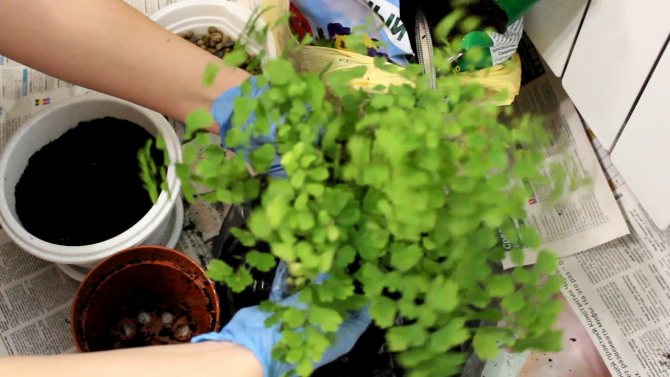

Pests and diseases of the maidenhair
In the chemical composition of the leaves of the maidenhair there are substances that repel insects, but modern pests have learned to adapt even to strong poisons, so the maidenhair sometimes infect mealybugs, scale insects, spider mites and aphids. The scale insects are removed from the leaves with an ear stick or brush moistened with alcohol.
Against aphids, the plant is treated with soapy water, followed by washing it off the leaves, and if this measure does not work, you can spray the adiantum with a solution of Actellik, Inta-vira, Decis, Derris, Biotlin, Antitlin or Fitoverm. The last three drugs are also used to combat mealybugs along with insecticides such as Confidor and Confidant, Mospilan or Aktara. Spider mites can be eliminated by treating the fern with Aktellik or Fitoverm.


The maidenhair is not affected by diseases, but sometimes maidenhair dries, or rather, from improper care, sometimes the maidenhair leaves dry and turn brown at the edges - usually this is due to insufficient watering or as a result of burning gas in the immediate vicinity of the plant.
If leaves fall off the fern, this indicates low humidity, so spray the plant more often and do not forget that watering should be regular. When the maidenhair leaves turn pale, this is a sign that it is out of place - move the pot with the plant where it will not be so bright.
Curled, but not drying fern leaves are a sign of too low a temperature with high room humidity.
- Pistia layered and its varieties
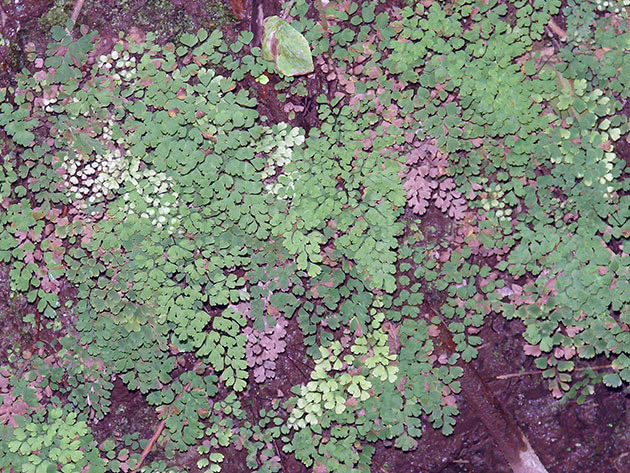

Properties of the maidenhair
The leaves of maidenhair contain triterpenoids, flavonoids, lipids, steroids, phenol carboxylic acids and their derivatives, as well as essential oil. Medicinal powders, infusions, syrups, which are widely used in Western Europe, are prepared from the leaves of the maidenhair. Aqueous extracts from maidenhair have antibacterial properties; infusions and syrups are used as an expectorant and antipyretic agent.
Preparations from maidenhair are used to treat diseases of the respiratory tract, as well as diseases of the liver, spleen and bladder. Fern leaf juice is used to make compresses and lotions against rabid animal bites for detoxification purposes and for the treatment of malignant ulcers. In Chinese medicine, decoctions from the leaves of the plant are successfully used to treat alcoholism.Adding maidenhair juice or a decoction of its leaves to water for rinsing hair can reduce dandruff, and alcoholic infusion helps in the treatment of psoriasis.
Interesting Facts
There is a mention of this flower in the writings of Pliny the Elder (ancient Roman writer). It says that the healers of those times, noticing the similarity of the foliage of the plant with curls, began to recommend it as a remedy for hair.
In the Caucasus, even today, some peoples rinse their hair with infusions of the hair veneer plant. They believe that thanks to him, their hair shines. A decoction from the leaves of this flower is used in China in the treatment of tobacco and alcohol addiction.
The maidenhair itself, as noted above, does not tolerate tobacco or any other smoke.
Maidenhair plant - reproduction
Reproduction of the maidenhair by dividing the bush
The maidenhair at home reproduces by spores and division of the rhizome. In the spring, during transplantation, an adult maidenhair taken from an old pot is cut into pieces with a sharp knife, the cuts are processed with crushed coal and the cuttings are planted in separate pots. If the fern has few growth points, then it cannot be divided, since the plant may die. Seated delenki do not immediately start growing, they take root for a long time.
Before dividing the rhizome, let the earthy coma dry out, and when planting the cut, make sure that the root collar does not end up too deep in the soil, as this can cause rotting of the shoots.
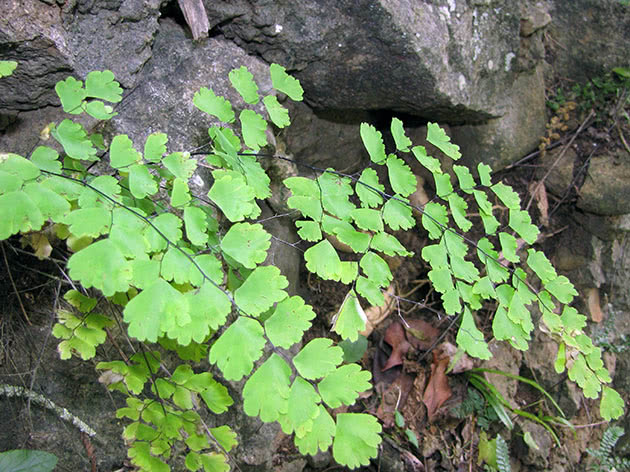

Seed propagation of maidenhair
For growing maidenhair from spores, shallow containers filled with a soil mixture consisting of one part of peat, half of sand and half of leafy earth are used. The soil mixture is compacted and scalded with boiling water. After it cools down, spread the maidenhair spores over the surface, cover them with glass and place the container in a dark, warm place. To disinfect the seed, it is sprayed with a pink solution of potassium permanganate. To speed up the emergence of seedlings, it is advisable to arrange the maidenhair under heating up to 21 ºC. The germination period of seeds is from one week to three months.
After the seedlings hatch, remove the glass and move the container to a well-lit, sunny place. When the seedlings get stronger, you need to cut them apart at a distance of 2.5 cm from each other, or even better, plant them 2-3 copies in pots with peat soil.
A bit of history
More than 200 years ago, the Venus hair flower settled in the human dwelling. Florists immediately appreciated the elegance of openwork leaves (their name is frond). In those days, this delicate plant, sensitive to air quality, could not adapt to simple stove-heated huts. Maidenhair and other fern species were grown only in the conservatories and greenhouses of wealthy families.
Central heating has improved the quality of the atmosphere in the apartments, so these flowers have begun to decorate the premises of a variety of houses. However, this was not without problems: the dry air of apartments with central heating negatively affected the health of the fern. Today there are many ways to create the moisture necessary for a plant, so a wonderful maidenhair is bred at home without much hassle.
Types of maidenhair
Adiantum capillus-veneris
It grows in the wild in the mountains of the Caucasus and Crimea, in Central Asia, preferring moist limestone stones near water sources. It has thin black rhizomes. The plant is named so because of the light, delicate fan-shaped light green leaves on petioles up to 25 cm long. It is grown mainly as a houseplant.
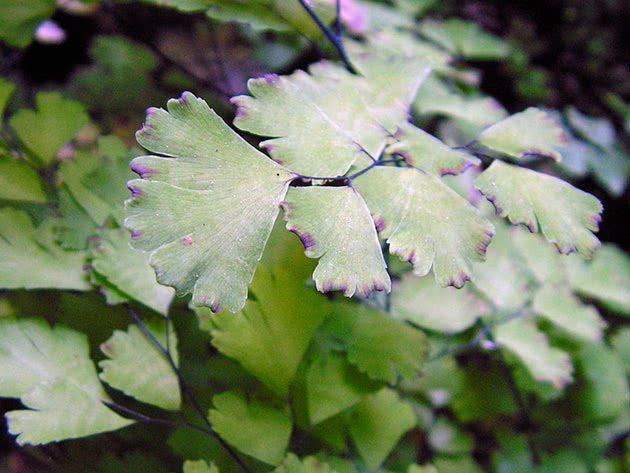

Adiantum pedatum
One of the most spectacular ferns, a graceful, openwork plant in the deciduous forests of East Asia and North America. This type of maidenhair reaches 60 cm in height, its leaves are flat, shiny, one-sided, light green, pinnately dissected, incised along the edges, located horizontally on thin shiny petioles.
The species is extremely winter-hardy - it can survive frosts down to -35 ºC.The best varieties of the species are:
- Compactum is a fern reaching a height of 35 cm;
- Imbricatum is a dwarf variety, a plant up to 15 cm tall;
- Aleutikum - the height of this maidenhair is only 10-12 cm with a bush width of 15-20 cm. Most often it is grown in a pot, since it tolerates the sun better than other ferns;
- Yaponikum - the height of this variety is about 45 cm, the diameter of the bush is about 30 cm. It differs in copper-pink shoots at a young age, which gradually turn green.
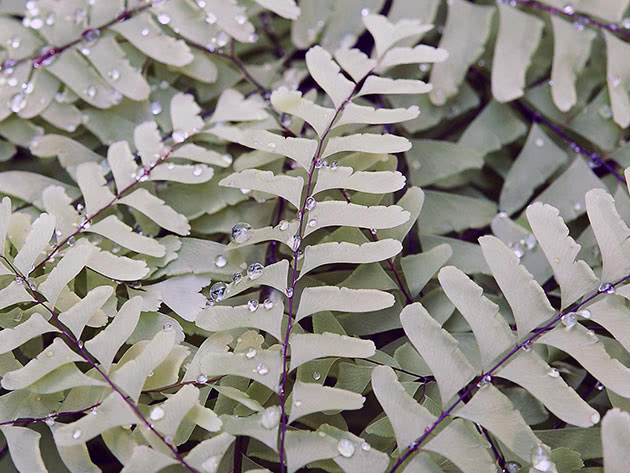

Gentle maidenhair (Adiantum tenerum)
Or maidenhair pink, lives in nature in the Lesser and Greater Antilles and in the tropical regions of America. This is a plant with a creeping short rhizome and with triple-feathery, wedge-shaped at the base and broadly lobed leaves about 70 cm long and up to 50 cm wide on the upper edge, located on petioles up to 30 cm long. Varieties:
- Farleyens - maidenhair with beautifully curled leaves;
- Scutum Roseum - young leaves of this variety, up to 30 cm high, have a changeable color from pale pink to green.
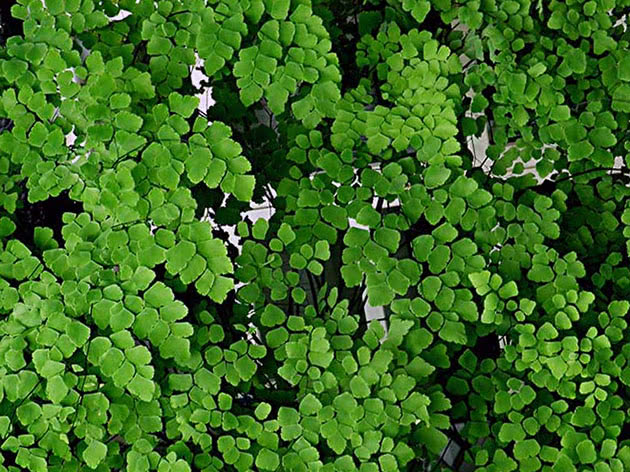

Small-haired maidenhair (Adiantum hispidulum)
Or maidenhair finely pubescent, grows in the African mountains along the snow line, as well as in India, Australia, New Zealand and Madagascar. The rhizome in plants of this species is creeping, the leaves are hand-dissected, 15 to 25 cm long, on petioles up to 35 cm long, covered with small bristles. Leaflets of the second order up to 2 cm long and up to 0.5 cm wide, also pubescent on both sides with small bristles, have a rhomboid shape. A wonderful houseplant.
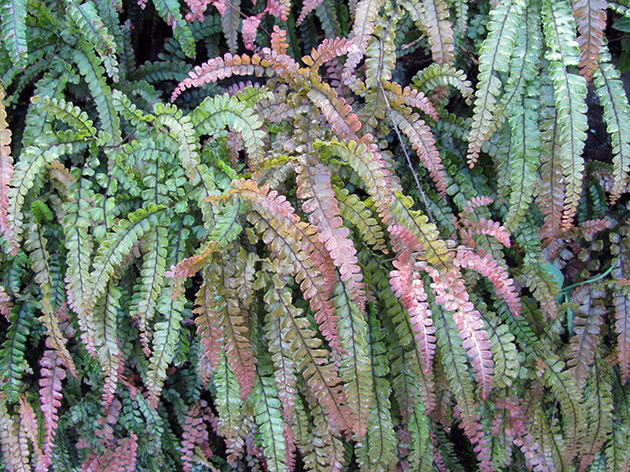

Adiantum raddianum
Or wedge-shaped (Adiantum cuneatum) Is an epiphyte native to the subtropical forests of Brazil. Leaves up to 45 cm in length and up to 25 cm in width are gracefully curved and dissected into many bright green leaves on shiny black petioles. The most common varieties in culture:
- Grasillium and Micropinnulum - these maidenhair leaves are finely dissected and require high air humidity, so it is best to grow these varieties in a florarium;
- Fritz Luth and Festum are much more resistant varieties that can be grown as indoor plants.
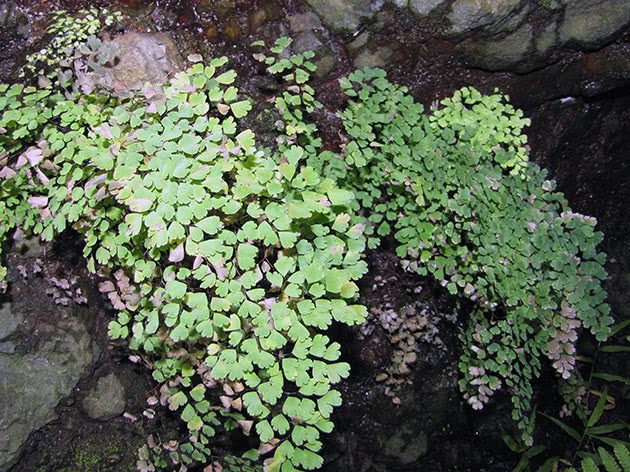

Adiantum caudatum
It is grown as an ampelous plant, since it forms leaves up to 60 cm long. The petioles of the leaves are brown, on the tops of the leaves there are offspring. Plants of this species react very painfully to dry earthen coma.
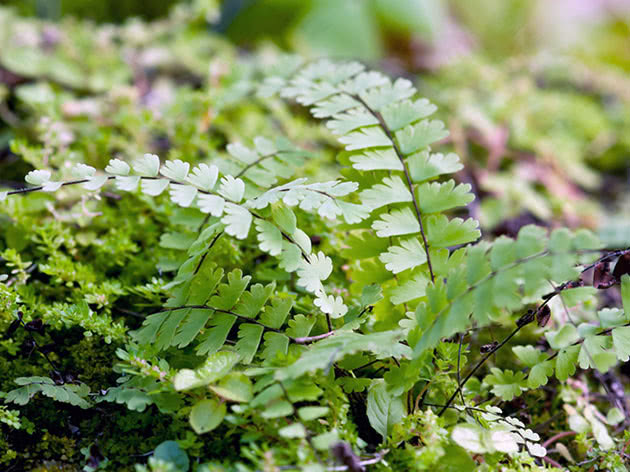

Beautiful maidenhair (Adiantum formosum)
Or maidenhair beautiful - a large plant up to a meter high with a very fragile rhizome and multi-pinnate leaf plates on purple-black petioles. Segments of leaves are dark green, triangular-obovate.
- How to properly keep a pistia in an aquarium
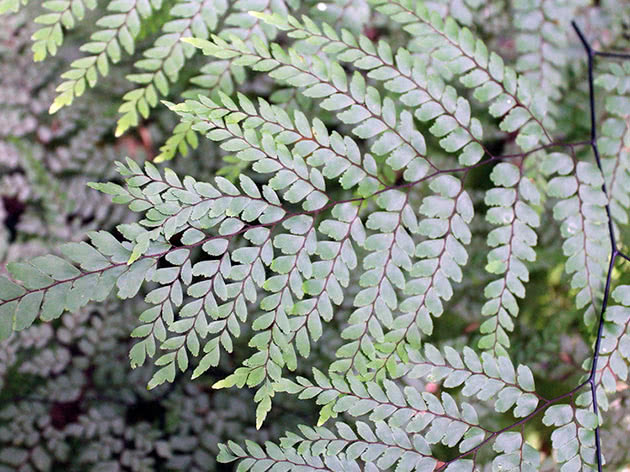

Adorable adiantum (Adiantum venustum)
The fern growing in Nepal and Kashmir forms narrow, up to 20 cm long, light green leaves on black-purple petioles with slightly pointed segments. After frost, the shade of the leaves becomes brownish.
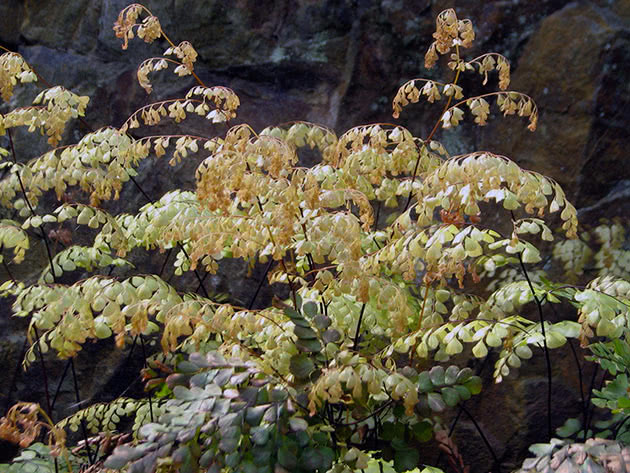

Wedge-shaped maidenhair (Adiantum cuneatum)
Very similar to the beautiful maidenhair, it differs only in the shape of the sori, which resembles a horseshoe. In nature, this species grows in the south of Brazil.
Transparent adiantum (Adiantum diaphanum)
Herbaceous plant 25-40 cm high with feathery leaves, double-pinnate at the base. Fries up to 3 cm wide and up to 20 cm long on thin twenty-centimeter petioles with bare broad-oval leaves of a dull green color.
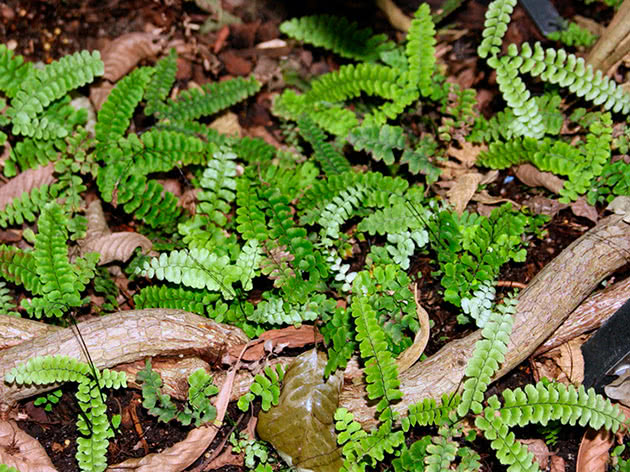

Adiantum Fragrans
Very often in the culture grown maidenhair fragrance - inhabiting the South American Andes and South Asia and forming dense bushes. It is a gentle, rapidly developing plant up to 50 cm high with pale green oval leaves up to 3 cm long and up to 1.5 cm wide on petioles 10-15 cm long.
Legends
There are several legends about the origin of the plant. One of them says that at the place where a young beautiful girl fell from a cliff, a waterfall broke through. Her hair turned into a fern.
According to another legend, the goddess of love Venus, cutting off her hair, dropped a small strand from which the maidenhair grew. Hence its name.
There are many different beliefs about fern flowering. Our ancestors believed that the fern blooms magically: on the eve of the summer solstice (the holiday of Ivan Kupala), a fiery flower sprouts, so bright that it is impossible to even look at it. And it blooms for only a few seconds. Then the fiery flower is plucked by an invisible force. But a person who ripped it off earlier can acquire power over everything. The ancestors could not understand how this plant reproduces. Therefore, similar legends about a fern with mysterious power were born then.
However, science has been able to debunk the mysteries of the fern. Absolutely all adiantums never bloom. Nature for them has provided a mechanism for reproduction by spores. They form in this plant from spring to autumn (along the edge of the leaves or at their tips, in sori). They acquire a brownish color as they mature. The spores are very fine, dust-like.
Pests
If you notice that the leaves of the plant are drying out, losing their shine and resembling paper, this is a sign that the plant has been exposed to excess sunlight or the soil is deprived of nutrients. Flower need fertilize once every 2 weeks... One must also remember about the sensitivity of this plant to smoke. Don't put the flower in the kitchen, near the stove or heating appliances, and forget about smoking indoors. The flower is attacked greenhouse whitefly... This insect resembles a white butterfly. The pest is destroyed by a drug that is sold in a houseplant store.
As for the method of application and the frequency of the procedure, it is worth consulting in this matter, for example, the seller offering these drugs. A white glomerulus attached to the leaves indicates the presence of a worm... Fight against it, brushing the pest away with a brush, soaked in denatured alcohol... This must be done carefully so as not to wet the leaves. On the underside of the leaves and on other parts of the plant appear small oval growths, leaves a pest california scaled... At the same time, one should not confuse scale insects with spores located on the underside of the maidenhair leaves. The spores are arranged in regular rows and are found only on the leaves and not on other parts of the plant. The scabbards are removed mechanically. In case of strong spread, use a chemical product.
